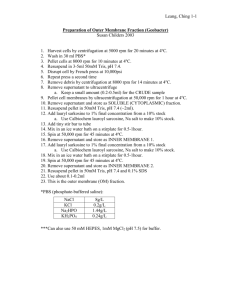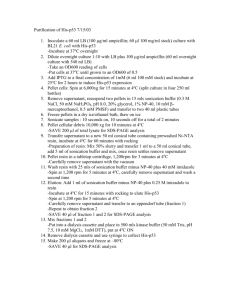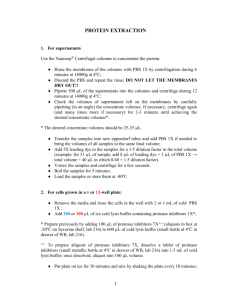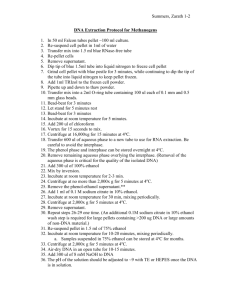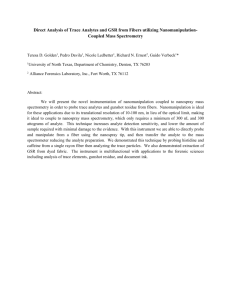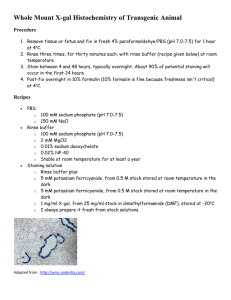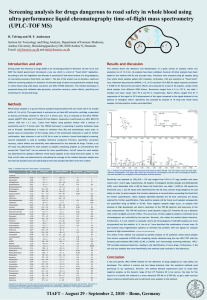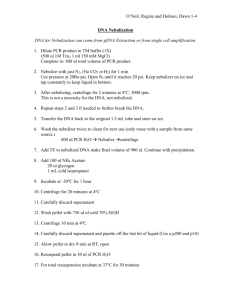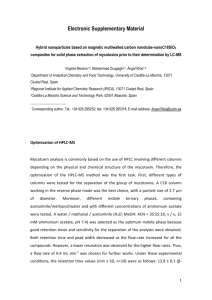Elevated Method Reporting Limits
advertisement
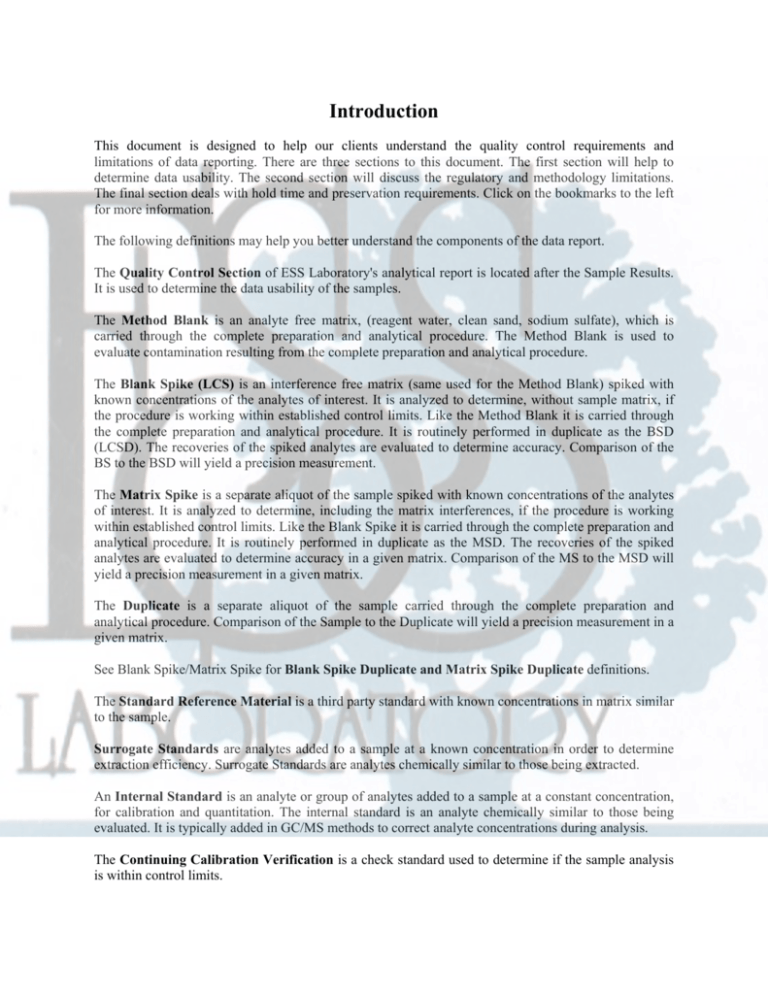
Introduction This document is designed to help our clients understand the quality control requirements and limitations of data reporting. There are three sections to this document. The first section will help to determine data usability. The second section will discuss the regulatory and methodology limitations. The final section deals with hold time and preservation requirements. Click on the bookmarks to the left for more information. The following definitions may help you better understand the components of the data report. The Quality Control Section of ESS Laboratory's analytical report is located after the Sample Results. It is used to determine the data usability of the samples. The Method Blank is an analyte free matrix, (reagent water, clean sand, sodium sulfate), which is carried through the complete preparation and analytical procedure. The Method Blank is used to evaluate contamination resulting from the complete preparation and analytical procedure. The Blank Spike (LCS) is an interference free matrix (same used for the Method Blank) spiked with known concentrations of the analytes of interest. It is analyzed to determine, without sample matrix, if the procedure is working within established control limits. Like the Method Blank it is carried through the complete preparation and analytical procedure. It is routinely performed in duplicate as the BSD (LCSD). The recoveries of the spiked analytes are evaluated to determine accuracy. Comparison of the BS to the BSD will yield a precision measurement. The Matrix Spike is a separate aliquot of the sample spiked with known concentrations of the analytes of interest. It is analyzed to determine, including the matrix interferences, if the procedure is working within established control limits. Like the Blank Spike it is carried through the complete preparation and analytical procedure. It is routinely performed in duplicate as the MSD. The recoveries of the spiked analytes are evaluated to determine accuracy in a given matrix. Comparison of the MS to the MSD will yield a precision measurement in a given matrix. The Duplicate is a separate aliquot of the sample carried through the complete preparation and analytical procedure. Comparison of the Sample to the Duplicate will yield a precision measurement in a given matrix. See Blank Spike/Matrix Spike for Blank Spike Duplicate and Matrix Spike Duplicate definitions. The Standard Reference Material is a third party standard with known concentrations in matrix similar to the sample. Surrogate Standards are analytes added to a sample at a known concentration in order to determine extraction efficiency. Surrogate Standards are analytes chemically similar to those being extracted. An Internal Standard is an analyte or group of analytes added to a sample at a constant concentration, for calibration and quantitation. The internal standard is an analyte chemically similar to those being evaluated. It is typically added in GC/MS methods to correct analyte concentrations during analysis. The Continuing Calibration Verification is a check standard used to determine if the sample analysis is within control limits. Quality Control Section The quality control section of the report is separated by analysis and then batches within the analysis. A batch of samples consists of samples that were prepared at the same time using the same preparation method. A batch can consist of up to 20 field samples prepared with a Method Blank (BLK), Blank Spike (BS or LCS), Blank Spike Duplicate (BSD or LCS Dup), Matrix Spike (MS) and Duplicate (DUP)/Matrix Spike Duplicate (MSD). These samples are designated as Batch#Abbreviation (ie BG92407-BLK1). The batch column on each analysis sheet will allow the data user to identify which QC is associated with each analysis. Method Blank (B) The Method Blank will show contamination that may have occurred during the preparation step. If the level of the analyte in the blank is greater than 10% of the level of the analyte in the sample, the sample will be flagged. This will alert the data user that a high bias should be taken into account. The flagged data will only be reported when the analytes in question are significantly lower than the regulatory limits or insufficient volume was received to perform a re-analysis. Levels of analyte in the blank below 10% of the level of the analyte in the sample would not be considered significant, should not be flagged and would not affect data usability. Blank Spike (B+,B-) The Blank Spike is a measure of the accuracy of the test procedure. If an analyte for any Blank spikes is outside of criteria, that particular analyte needs to be evaluated. If Blank Spikes are above criteria, there is possibility of a high bias; below criteria, there is a possibility of a low bias for the analytes being evaluated. High bias would not be of concern for samples under a regulatory limit. Low bias would be of concern for samples that are under a regulatory limit depending on proximity to the limit. Extrapolation based on percent recovery would be advisable, however extremely low recoveries would affect data usability. Matrix Spike (M+,M-) The Matrix Spike is a measure of accuracy with regards to matrix effect. It is evaluated in the same way as the Blank Spike. The difference being that analytes that are outside of criteria in the Matrix Spike and not in the Blank Spike are showing matrix effects. Again extrapolation can be used however extremely low recoveries affect data usability. Blank Spike Duplicate, Duplicate and Matrix Spike Duplicate (D+) The Blank Spike Duplicate, Duplicate and Matrix Spike Duplicate are measures of precision. The Blank Spike Duplicate tests the precision of the procedure; the other two test the precision in regards to matrix. If the Duplicate and/or Matrix Spike Duplicate are outside of criteria, while the Blank Spike Duplicate is acceptable, it is assumed that the sample is non-homogeneous. This data would represent a range more than a finite point. Standard Reference Material (R+,R-) The Standard Reference Material is a measure of the accuracy of the test procedure for a particular matrix. If an analyte for any Standard Reference Material is outside of criteria, that particular analyte needs to be evaluated. If any Standard Reference Material analytes are above criteria, there is possibility of a high bias; below criteria, there is a possibility of a low bias for the analytes being evaluated. High bias would not be of concern for samples under a regulatory limit. Low bias would be of concern for samples that are under a regulatory limit depending on proximity to the limit. Extrapolation based on percent recovery would be advisable, however extremely low recoveries would affect data usability. Surrogate Recoveries (S+,S-,SC,SM) Surrogate recoveries represent the extraction efficiency for groups of analytes within a sample. Each surrogate represents a group of analytes. If surrogate recoveries are above criteria, a high bias is assumed for that group of analytes; below criteria, a low bias is assumed. High bias would not be of concern for analytes that are under a regulatory limit. Low bias would be of concern for analytes that are under a regulatory limit depending on proximity to the limit. Extrapolation based on percent recovery would be advisable, however extremely low recoveries would affect data usability. See Table for relationship between analytes and the surrogates. When surrogates fail they may be qualified as confirmed (second run performed with same results) or matrix (matrix interfered with quantitation of the surrogate – A chromatogram can be provided to document the problem). SVOA Surrogate Information VOA Surrogate Information EPH Surrogate Information UCM/Coelution (SM) It may not be possible to calculate Surrogate Recoveries due to unresolved complex mixture (UCM/Coelution). The surrogate peak can not be distinguished or separated from the mixture of components that are present in the sample. A chromatogram can be provided to document the problem. Internal Standards (I,IC,IM) Internal Standards are used to quantify a group of analytes. If Internal Standard recoveries are outside of criteria, the analytes represented by that particular Internal Standard need to be evaluated. If the matrix has coeluted with the Internal Standard to create a higher result, the data would have a low bias. Otherwise Internal Standards outside of criteria have caused the data to be adjusted more than the method allows for but does not necessarily create a bias one way or the other. This data is suspect and should not be used for important decision making. See Table for relationship between analytes and the internal standards. When internal standards fail they may be qualified as confirmed (second run performed with same results) or matrix (matrix interfered with quantitation of the internal standard – A chromatogram can be provided to document the problem). SVOA Internal Information VOA Internal Information Continuing Calibration Verifications, CCV (CD+,CD-) Continuing Calibration Verifications (CCVs) are used for analyses that do not require a daily calibration. If CCV recoveries are above criteria, a high bias is assumed for that analyte; below criteria, a low bias is assumed. High bias would not be of concern for analytes that are not detected or under the regulatory limit needed. Low bias would be of concern for analytes that are under a regulatory limit depending on proximity to the limit. Extrapolation based on percent recovery would be advisable, however extremely low recoveries would affect data usability. Elevated Method Reporting Limits (EL) Elevated Method Reporting Limits are caused by target analyte dilution or matrix interferences. Samples are diluted when an analyte exceeds the highest level calibration standard. If the level of the analyte does not cause the run to be unusable, the original run and diluted run can be reported. If the level of the analyte causes the run to be unusable (saturates the detector), only the diluted run will be reported and flagged for Elevated Method Reporting Limits. Samples are also diluted when there is a large matrix interference that cannot be cleaned up prior to running the sample. The sample must be diluted so that the interference does not mask the analyte(s). Once the interference has been negated, the analyte(s) can be reported. This may cause the Method Reporting Limit to exceed the method limits or the regulatory limit. In this case, the sample will be flagged accordingly. Diluted Below (SD) It is not always possible to evaluate surrogate and matrix spike recoveries in a diluted sample. If the dilution is large enough, the concentrations of surrogates will be diluted below the Method Reporting Limits. These samples will be flagged accordingly. Matrix Masked/Coelution (DM,MD,MM,MT) Samples with high target values or matrix interferences can mask the recovery of the analytes or co-elute with the analytes. The analytes can not be accurately distinguished or separated from the existing concentrations of target analytes or other unknown components that are present in the sample. These samples will be flagged accordingly. Quadratic Regressions (Q) Quadratic Regressions are an allowable form of calibration for organic compounds. This calibration should be kept to a minimum. A large number of quadratic regressions indicate that the instrument is not running properly. Analytes using quadratic regression should not be evaluated outside of the calibration range (no “E” flags or “J” flags should be used). Dual Column Confirmation (P) Some organic analysis using GC (Pesticides, PCBs, etc) requires dual column confirmation of all reportable results. Samples are run on two different columns and results should agree to within 40%. Results outside of 40% are reviewed by analysts for interference or coelution and flagged accordingly. The result reported is the value considered to have the best chromatography. Benzidine/Pentachlorophenol Tailing Factor (BT,PT) Tailing factor is used to evaluate the performance of the SVOA Mass Spec instrument. When the tailing factor is >2, the columns are showing some signs of deterioration which will occur with continual use. The tailing factor must be narrated and instrument maintenance will be performed as necessary. This may affect the chromatography of all analytes, however, it does not add bias to the data reported. Initial Calibration Verification (ICV) The Initial Calibration Verification is a second source standard used to verify the calibration curve. While the CAM allows for some failures, it is not possible to judge the bias as high or low. Estimated Value (E) When an analyte is reported above the high point of the calibration curve, the analyte is considered an Estimated value and qualified accordingly. Potential Presence of PCBs (PP) The PP Qualifier is used when the chromatogram shows the potential presence of PCBs in a sample. While the peaks and patterns may not be exact, the analyst has determined that the PCB may be present in a weathered state. Reducing Conditions (R) The eH-pH data is used to determine whether Chromium could exist in the Hexavalent state in a particular sample. The R qualifier is used to explain the low matrix spike recoveries in a sample when it is not possible for Hexavalent Chromium to exist. Serial Dilution (SD+) The Serial Dilution is used to determine matrix interference in Metals samples. For samples containing analytes greater then 50 times the reporting limit, the serial dilution should be within 10%. Results greater then 10% would indicate a low bias for that analyte. CAM Method Limitations 1,4 – Dioxane Must use 8270D SIM 8260 Aqueous 1,2-Dibromoethane (EDB) – must use 8011 to achieve GW1 and RCGW1 limits. 1,4-Dioxane – must use 8270 with isotope dilution to achieve GW1 and RCGW1 limits. 8260 Soil Must use Low Level method to achieve S1GW1, S2GW2 and RCS1 limits for: 1,1,2,2-Tetrachloroethane 1,4-Dioxane 4-Methyl-2-Pentanone cis-1,3-Dichloropropene Dibromochloromethane Methylene Chloride trans-1,3-Dichloropropene In addition, must use Low Level method to achieve S1GW2, S2GW2, S2GW3 and RCS2 limits for: 1,1,2,2-Tetrachloroethane Dibromochloromethane Meeting required limits will also be affected by sample size, dilution and percent solids. The laboratory will make the best effort to compensate and meet all limits. However, some samples will not be able to be reported below required limits. Use the Limit Checker EDD to review limit exceedances. RCP Method Limitations 1,4 – Dioxane Must use 8270D SIM 8260 Aqueous 1,2-Dibromoethane (EDB) – must use 8011 to achieve GA GWPC criteria. 8260 Soil Must use Low Level method to achieve Residential: 1,2-Dibromoethane (EDB) Must use Low Level Method to achieve GA and GAA Mobility: 1,1,1,2-Tetrachloroethane 1,1,2,2-Tetrachloroethane 1,2-Dibromoethane (EDB) 1,2-Dichloroethane Acrylonitrile Benzene Bromodichloromethane Chloromethane cis-1,3-Dichloropropene Dibromochloromethane Methylene Chloride Trans-1,3-Dichloropropene Vinyl Chloride Must use Low Level Method to achieve GB Mobility: Acrylonitrile Meeting required limits will also be affected by sample size, dilution and percent solids. The laboratory will make the best effort to compensate and meet all limits. However, some samples will not be able to be reported below required limits. Use the Limit Checker EDD to review limit exceedances. ESS Laboratory’s Guide to Sample Handling and Preparation Analysis Chlorine (TRC) Dissolved Oxygen pH Sulfite Temperature Chromium (VI) Coliform Ferrous Iron Iodide Odor Plate Count BOD – 5 day Color Nitrate Nitrite Orthophosphate Settleable Solids Surfactants (MBAS) Turbidity Sulfide TOX (VOA vial) Flash/Reactivity Preservative Aqueous Soil Hold Time Water Soil 4oC Immediate N/A 24 hrs 4oC 28 d 24 hours 4oC 48 hours Vol ml 50 300 50 N/A N/A 50 100 100 100 100 200 50 25 25 25 1000 250 50 50 40 pH check NO NO NO Zn Ace/NaOH - 4oC H2SO4 or HCl - 4oC NP - 4oC 4oC 4oC NP - 4oC 4oC 4oC 100 Acidity/Alkalinity TX (VOA vial) Cyanide (Amenable) Cyanide (Total) 4oC 4oC NaOH - 4oC NaOH - 4oC 4oC 4oC NP - 4oC NP - 4oC NO 14 days 100 400 100 100 Metals* (Total/Diss.)Except Cr(VI) and Mercury Mercury* (Total/Diss.) HNO3 - 4oC 4oC HNO3 - 4oC NP - 4oC 6 months 100 Yes 28 days 50 250 25 250 25 1000 250 50 40 N/A N/A N/A 25 25 50 50 50 50 1000 Yes TDS/TS/TSS/TVS Ammonia COD Kjeldahl Nitrogen (Total) Nitrate-Nitrite Oil & Grease/TPH Glass only Phenol Glass only Phosphorous (Tot/Hyde) TOC (VOA vial) Paint Filter Asbestos Bromide Chloride Fluoride Salinity Silica Spec. Conductivity Sulfate Siloxane SVOA (625/8270/PAH) DRO/TPH-GC (8100M) EPH Herbicides (8151) PCB (608, 8082) Pesticide (608, 8081) Volatile Organics (524.1, 601, 624, 5035, 8260) EDB & DBCP GRO VPH 7 days NO 4oC NP - 4oC 4oC H2SO4 NP None Required 28 days 4oC 4oC NP - 4oC NP - 4oC HCl - 4oC HCl - 4oC NP - 4oC NP - 4oC 5-9 pH - 4oC 4oC Na2S2O3 - 4oC HCL - 4oC HCL - 4oC *** MeOH - 4oC NP - 4oC NP - 4oC NP - 4oC NP - 4oC NP - 4oC NP - 4oC MeOH** - 4oC NP - 4oC NP - 4oC MeOH** - 4oC Yes NO 7d 7d 14 d 7d 365 d 7d 14 d 14 d 14 d 14 d 365 d 14 d 2000 1000 1000 1000 1000 1000 Yes 14 d 14 d 3 vial Yes 14 d 28 d 3 vial *** * Dissolved metals must be field filtered before preservation or brought to lab unpreserved and filtered in lab within 24 hours. ** Samples are to be preserved in the field with methanol. ***These parameters must be tested in sample receiving for pH – Cyanide, Pesticide (608)
